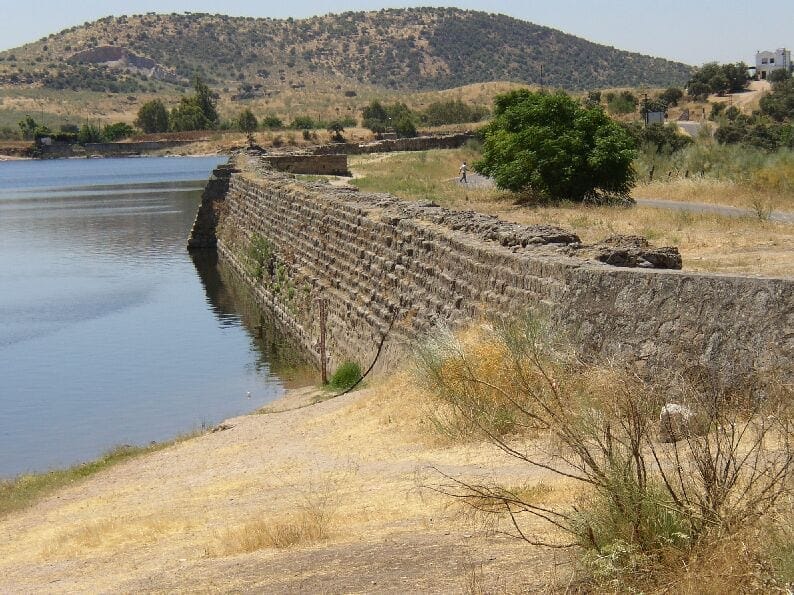“They don’t build them like they used to.” It’s a common lament when we see modern buildings that don’t quite measure up. But some structures from the ancient world were built to last, and are still used today. These enduring buildings, crafted from stone, timber, and concrete, continue to serve their communities centuries after their creation. Let’s explore ten amazing examples of ancient architecture that are still standing and functioning today.
Proserpina Dam

Modern dams often require constant maintenance, but the Proserpina Dam in Spain has stood for nearly 2,000 years. Built in the 2nd century AD by Roman engineers, it supplied water to the city of Augusta Emerita, now Merida. The dam, 12 meters high and over 400 meters long, was made from soil covered in bricks and supported by buttresses. While it no longer provides drinking water, local farmers still use its water to irrigate their crops, just as the original builders intended.
Arles Amphitheatre
The Romans constructed impressive structures to showcase the benefits of their rule. The amphitheater in Arles, erected in 90 AD, could hold 20,000 people. It hosted animal fights, theatrical shows, and gladiator combats for over 400 years. After the fall of Rome, it was repurposed as a fortress, with 200 houses and churches built within its walls. Restored in 1826, it now hosts plays, concerts, and even bullfights, keeping its entertainment legacy alive.
Theatre of Marcellus
The Theatre of Marcellus in Rome, built in 13 BC, was once the city’s largest theater, holding almost 20,000 spectators. Named for Emperor Augustus’s nephew, it fell into disrepair in the 4th century AD, and some of its materials were reused. However, much of the structure survived, becoming a fortress and then a private home for the Orsini family. Today, it’s divided into apartments, its arches standing proudly as a testament to its enduring legacy.
Theatre of Epidaurus
Built in the 4th century BC by Polykleitos the Younger, the Theatre of Epidaurus was constructed on a naturally occurring slope. Located at a sanctuary dedicated to Asclepius, the Greek god of healing, it hosted singing and theatrical performances believed to aid in curing illnesses. Rediscovered in 1881 and restored, it remains a popular venue for music and theatre, renowned for its exceptional acoustics.
Diocletian’s Palace
Emperor Diocletian retired to a palace in Split, Croatia, in 305 AD. More than a retirement villa, it was a fortified complex. In the 7th century, locals sought refuge within its walls during Slavic invasions, turning the palace into the nucleus of a town and later a city. Today, the old town of Split is largely within the palace walls, with homes, shops, and churches coexisting with the original structure.
Maymand Caves
In Maymand, Iran, caves have been inhabited for 3,000 years. These caves, carved out of the rock, provide insulation from harsh weather and are easily sealed for protection. Today, 300 caves exist in the village, stacked in steps up the side of a slope. Each cave consists of a single room with a stove for heating and cooking, continuing a tradition of cave dwelling.
Mundeshwari Temple

The Mundeshwari Temple in Kaura, India, is believed to be the oldest functional Hindu temple in the country, dating back to around 600 AD. The octagonal stone shrine is dedicated to the god Shiva. Covered in engravings and decorations, it remains a place of worship for many Hindus, with the smoke from torches and incense marking centuries of devotion.
Castel Sant’Angelo
Castel Sant’Angelo in Rome began as Emperor Hadrian’s mausoleum. Over time, it transformed into a fortress for Popes, a prison, and now a museum. Integrated into Rome’s walls, it served as a military site and stronghold. Today, it houses Roman and Christian masterpieces, blending history and art in a unique setting.
Horyu-ji
The pagoda at Horyu-ji in Japan is considered the oldest surviving wooden building in the world. The central wooden pillar dates back to 594 AD. Despite a fire in 670 AD, many of the buildings were rebuilt in the 7th century and have survived wars and earthquakes. Still a site of worship, it provides insight into early Chinese Buddhist architecture in Japan.
Tower of Hercules Lighthouse
On the coast of Spain, the Tower of Hercules is the oldest functioning lighthouse in the world. Built in the 2nd century AD, it was modeled after the Pharos of Alexandria. Originally called “Farum Brigantium,” it stands 55 meters tall, with additional levels added in the 18th century. It continues to guide ships, maintaining its ancient purpose.
These ten ancient buildings showcase incredible engineering and enduring design. From dams and amphitheaters to temples and lighthouses, they stand as testaments to the ingenuity and resilience of past civilizations. Their continued use connects us to history, reminding us that some things truly are built to last.
What do you think about the lasting legacy of these ancient structures? Leave your comment below!










